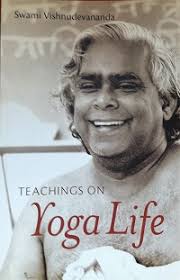Swami Vishnudevananda
A Dynamic Yogi
Swami Vishnudevananda was sent to spread the message of Yoga and Vedanta in the West in 1957 by his Master, Swami Sivananda, with the words “People are waiting”. For 37 years he worked tirelessly as an active and dedicated spiritual teacher travelling around the world establishing city Centres and Ashrams where his work could be accomplished.
Read about the life of Sri Swami Sivananda Maharaj >>Hatha Yoga Professor
The Early Years
Swami Vishnudevananda was born in the south Indian state of Kerala on December 31, 1927. After completing school he entered the Engineering Corps of the Indian Army. It was while he was in the army that he first met Swami Sivananda, one of the great saints of modern times. After being discharged from the army, Swamy Kuttan Nair, as he was then known, was a schoolteacher in his native Kerala for a short while, before leaving his life behind and entering the Sivananda Ashram in Rishikesh in 1947. Within a year, he took the monastic vow (sannyas) with the name of Swami Vishnudevananda. Swami Sivananda saw in his young disciple special tendencies towards Hatha Yoga. With his training directed towards this discipline he became an expert, mastering many of the most difficult and advanced Hatha Yoga techniques (asanas, pranayamas, mudras, bandhas and kriyas). How did he learn these ancient practices which to a great extent had been lost in modern India? He often said, “My Master touched me and opened my intuitive eye. All this knowledge returned to me from past lives”. Remaining at the Ashram for ten years, he was appointed as the first Professor of Hatha Yoga at the Yoga Vedanta Forest Academy. He held a number of other positions at the Ashram, including personal secretary to Swami Sivananda.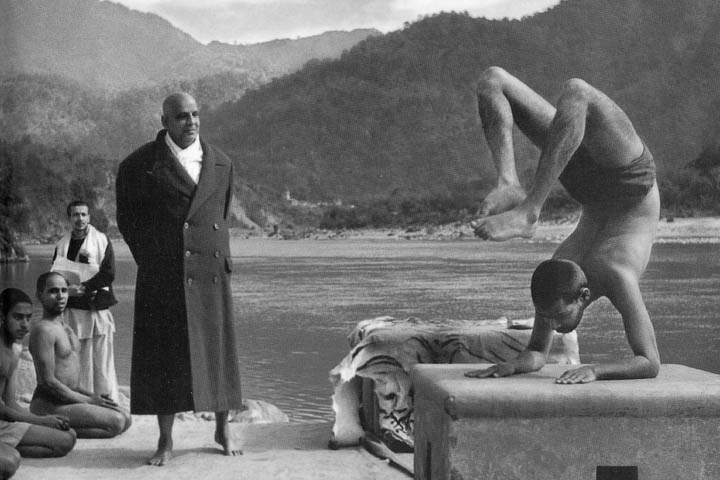
How Swami Vishnudevananda met his Master
Swami Vishnudevananda remembers his very first contact with Swami Sivananda: “I first heard about Swami Sivananda in a strange way. Looking in the waste paper basket for a lost paper, I found one small pamphlet called Sadhana Tattwa. His teachings were so simple and straightforward, ‘an ounce of practice is worth a ton of theory.’i I got a couple of days’ leave of absence from the army and went to see him. There was no kind of religious hypocrisy, no sitting on a tiger skin with ashes smeared all over his body. He had an extraordinary spiritual glow. The second time I saw him, Swami Sivananda was coming up the stairs in my direction. I didn’t want to have to bow my head to him. I was young and arrogant and never wanted to bow my head to anybody. But it is the tradition that you should bow your head to a holy man. To avoid the situation, I just moved out of his path. Master saw me and headed in my direction. He asked me who I was and where I was coming from. Then he bowed down and touched my feet!! My whole body began to shake violently. With all my heart, with all my life and love, I learned to bow without any type of reservation. He touched my heart not with miracles or shows of holiness, but with his perfect egoless nature. He didn’t consider that I was just a stupid boy standing there, although I was just that. He touched my heart and broke that egoism in me. I didn’t think anything else in this world would have broken this ego. That was my first lesson, and if I could attain one millionth of the state of egolessness of the Master, it is His Grace.” View this photo album of Swami Vishnu’s advanced asana practice >>“Health is Wealth.
Peace of Mind
is Happiness. Yoga shows
the Way.”
Coming to The West
Upon leaving India for the West, Swami Vishnudevananda spent a year travelling, arriving on the West Coast of America in 1957. It soon became apparent that Westerners were so caught up in the whirlwind of their lives that they neither knew how to relax nor how to live healthy lives. Swami Vishnudevananda devised the concept of the Yoga Vacation and set about creating places where people could have a complete rest of body, mind and spirit. Several Ashrams and Centres were founded based on an integrated approach to yoga.Teachers‘ Training Courses
In 1969 the True World Order was established to help create unity and understanding between peoples of the world. A unique Yoga Teachers’ Training Course was developed with the aim of training future leaders and responsible citizens in the basics of yoga discipline. Swami Vishnudevananda emphasized the importance of first finding individual inner peace which could then lead to establishing global peace and harmony. The first Sivananda Yoga Teachers’ Training Course was held in 1969 at the Sivananda Yoga Camp headquarters in Val Morin, Quebec, Canada and to date more than 45,000 people have graduated successfully from the course – many having gone on to spread the teachings of yoga around the world.The Five Points
-Proper Exercise
-Proper Breathing
-Proper Relaxation
-Proper Diet
-Positive Thinking & Meditation
The Five Points
By closely observing the lifestyles and needs of people in the West, Swami Vishnudevananda synthesised the ancient wisdom of yoga into five basic principles that could easily be incorporated into daily life to provide the foundation for healthy living. It is around these five principles that the activities at the Sivananda Yoga Vedanta Centres are based.
Proper Exercise (Asanas) acts as a lubricating routine for the joints, muscles and other parts of the body by increasing circulation and flexibility. The asanas not only produce physical benefits, but are also exercises in concentration and meditation, promoting optimum health.
Proper Breathing (Pranayama) connects the body to the solar plexus, where tremendous potential energy is stored. Through specific breathing techniques this energy is released for physical and mental rejuvenation.
Proper Relaxation (Savasan) is a vital part of keeping the body and mind healthy. Yoga teaches three levels of relaxation – physical, mental and spiritual.
Proper Diet (Vegetarian) is eating with awareness. A yogi takes food that has the most positive effect on the body and mind and the least negative effect on the environment.
Positive Thinking and Meditation (Vedanta and Dhyana) relieve stress and replenish energy. Meditation is well known to improve concentration and to bring peace of mind and spiritual strength. Meditation is beneficial for everyone, especially those with a hectic, stressful life.
The Complete Illustrated Book of Yoga
Swamiji’s Books
In addition to being a tireless worker for world peace and a renowned authority on Hatha and Raja Yoga, Swami Vishnudevananda is well known for his books The Complete Illustrated Book of Yoga and Meditation and Mantras. He also authored a commentary on The Hatha Yoga Pradipika and is the inspiration behind The Sivananda Book of Yoga.Peace Missions
In 1968 Swami Vishnudevananda had a vision of the world being destroyed by fire, of people fleeing in turmoil breaking down the barriers between nations in an attempt to escape. From that moment on, he embarked on a series of peace missions whose purpose was to show ‘that the idea of nationalism, or patriotism must disappear, and only one unity should exist.’ In 1971 he made headlines around the world by flying his two-seater Piper Apache plane over areas of serious conflict including Northern Ireland, the Suez Canal and the India Pakistan border. He ‘bombed’ these troubled areas with flowers and leaflets calling for peace. He also sponsored numerous festivals, conferences, symposiums and world tours – all calling for world peace and understanding. In 1983 he made an historic and perilous journey across the Berlin Wall from West to East in a microlight aeroplane, the first to be made by a private plane since the wall was erected twenty years previously. Swami Vishnudevananda recounts his Berlin Wall flight: “Just a few weeks ago I flew over the Berlin Wall with flowers in my hand. Everybody thought I’m going to be shot down. But I said, when I come with the flowers, how can anyone shoot. East Germans and West Germans, what is the difference? There was only one Germany. The moment that you put labels, then you think a person is not a human being. He should be shot. That’s what Catholics and Protestants, Hindus and Muslims, black and white, Arabs and Jews are doing. They put labels. The moment you put the label, you forget. You are no longer a human being. They can be easily killed. So when I went, I went with the label removed. The Berlin Wall crossing was symbolic. The purpose was to break the man-made barriers that exist in the mind. That’s the real barrier.”An Enduring Legacy
Swami Vishnudevananda was an innovator and a pioneer in his methods of disseminating the classical Yoga teachings that he learned from his Master, Swami Sivananda and to whom he dedicated his life’s work. He demystified yoga and offered clear, practical techniques for people to spiritualise their lives and attain health, mental balance and inner peace.
Perhaps his greatest contribution was to popularize Yoga philosophy and practice throughout the West by establishing worldwide network of Centres and Ashrams that made yoga easily accessible to all. The key to this injection of Yoga into the mass culture was the founding of the Sivananda Teachers’ Training Courses in 1969 to train people in the essence of Yoga and Vedanta. He asked his teachers to be practitioners, and not mere preachers, and to date countless graduates are now teaching throughout the world.
Swami Vishnudevananda used to say, “Before you can change the world, first you have to change yourself. The only way to change society is like changing a cotton cloth to a silk one – by changing each thread one by one”. Through this vast network of Yoga teachers, the social fibre is changing.
Mahasamadhi
Swami Vishnudevananda left his body on November 9, 1993, leaving behind him a worldwide organisation with 7 Ashrams and 20 Centres plus many affiliated Centres and teachers dedicated to propagating the ancient and timeless wisdom of yoga.
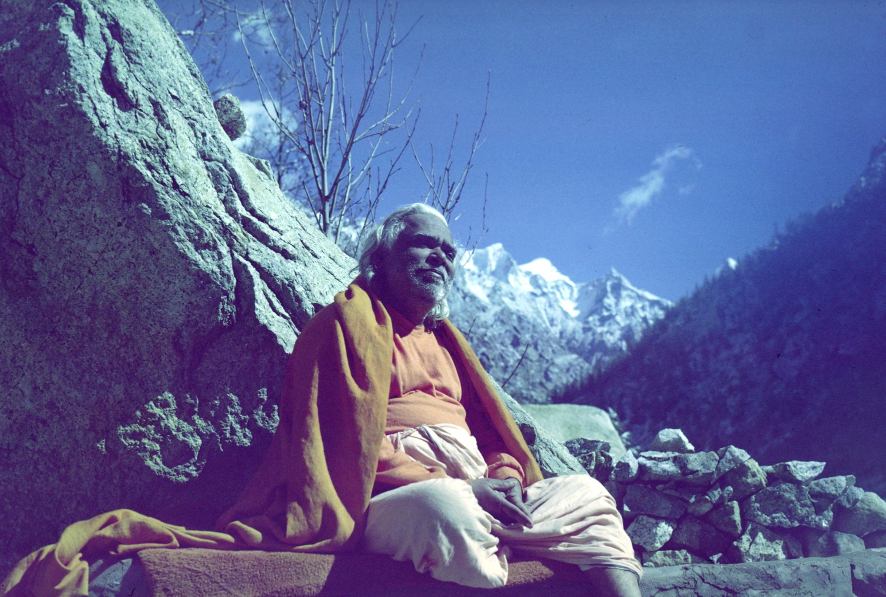
Books by or about Swami Vishnudevananda
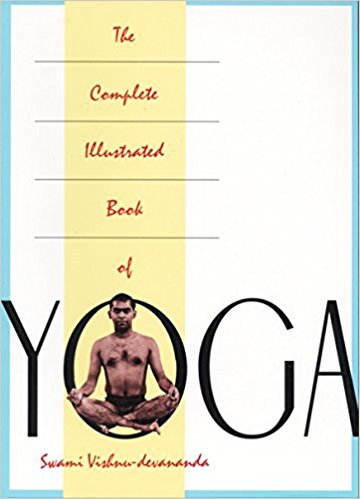
The Complete Illustrated Book of Yoga
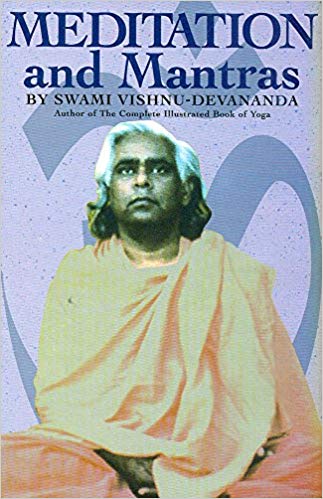
Meditation and Mantras
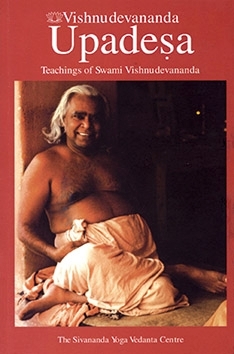
Vishnudevananda Upadesa
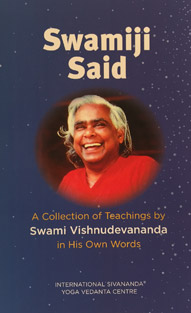
Swamiji Said
